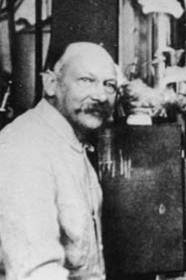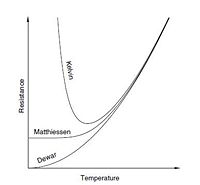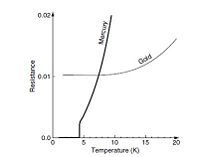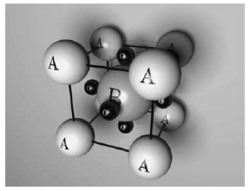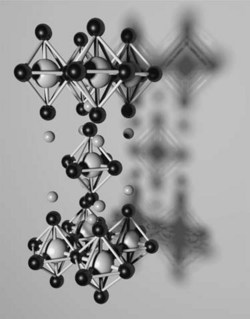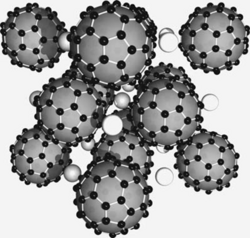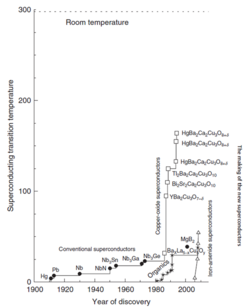Quest for High-Temperature Superconductors
The quest for high-temperature super conductors has been a focus of solid state physics since its discovery in 1911. The maximum temperature at which a material exhibits superconductivity has grown since the phenomena’s initial discovery and the availability of new materials with these amazing properties has allowed for incredible advancements in medical, research, and other emerging technologies.
The Quest Begins
What originally began as a quest to reach absolute zero and solidify all the elemental gasses, eventually led to the discovery of Superconductivity in 1911. Earlier in the century, the discovery of chlorine had sparked a race amongst chemists to liquefy the elemental gasses. After the development of production techniques for liquid helium, new research investigations could begin on properties of materials at the low temperature scale. Kamerlingh Onnes, one of the world’s premiere low temperature experimentalists at the time, sought to solve the question of ‘what happens to the resistivity of metals at low temperatures? Several predictions had been made at the time by some extraordinary theorists. Upon testing the resistivity of Mercury, Onnes quickly discovered that at a critical temperature, the resistivity of the element completely vanished. Initially, Onnes was skeptical of the data, further investigation was needed. Onnes knew that a material with zero resistance would have a wide range of applications. After confirming his results, Onnes imagined creating large superconducting magnets from the material. Unfortunately, he soon discovered that applying a magnetic field to the material quickly destroyed the property of superconductivity. Before his death in 1926, Onnes correctly predicted the growth of low temperature physics laboratories, superconducting magnets, and other advancements in solid state physics. In addition to his tremendous legacy, Onnes left a challenge to future generations: To create superconducting materials that could withstand higher temperatures and carry stronger currents; higher temperatures, being the key to lowering cooling costs and increasing practicality.
Attempting to Explain Superconductivity
Since its discovery, several theories have been proposed to explain superconductivity. Yet to this day, there is no universally accepted theory. Superconductivity has baffled some of the greatest minds and lay waste to some of the most well-reasoned theoretical models in Physics. Originally, it was thought that because mercury was mostly free of impurities that it was imperfections in a material that caused resistance. This was due to the scattering of electrons traveling in the sample. This was proven incorrect by Onnes; adding impurities to mercury did not raise its resistance when below the critical temperature. It wasn’t until 1956 that theoretical work was able to produce a seeming sound model for superconductivity. BCS theory seemed to have finally explained the phenomena. However, in the 1980s, new superconducting materials were discovered that exceeded the limit proposed by BCS theory. Nevertheless, the concepts proposed in BCS theory still provide the modern framework for understanding superconductivity.
BCS Theory
To explain super conductivity it was proposed that electrons in super conducting materials form pairs (cooper pairs). These pairs were shown by Cooper to be energetically favorable; it was energetically favorable to have an attraction between electron pairs. The energy required to break these pairs explained the energy gaps in superconductors and their dissimilarity to metals. However, cooper pairs alone did not solve the issue of superconductivity. That task remained to Bob Schrieffer, a graduate student working with Cooper under the supervision of Bardeem (the B in BCS and co-father of the transistor). Schrieffer attempted to find a wave function describing electrons in a superconducting material. For Cooper Pairs, Cooper had only considered one pair of electrons at a time and treated the rest of the 10^23 fermions as immobile, Schrieffer realized, while traveling by subway, that in order to represent the wave function properly, he had to consider all the electrons acting in harmony. In other words, the wave function would take into account the density of electrons and ignore the actual number discrete inside a material. This would lead to the BCS wave function. Superconductivity could now be described as an emergent property, similar to magnetism; a ‘macro’ quantum state due to a fixed phase of the electrons. In a superconductor, it was believed that all the individual electron’s wave functions were in phase. Also, Landau’s work on symmetry breaking, allowed for an explanation of how superconductivity undergoes a sudden transition from superconductor to non-superconductor. It seemed for the very first time that Superconductivity was explained. Unfortunately, BCS theory seemed to predict a theoretical maximum temperature near 30 degrees Kelvin. It seemed for now that Onnes’ dream of high temperature superconducting materials was impossible.
New Developments and Higher Critical Temperatures
Although BCS theorem predicted a theoretical maximum critical temperature, researchers continued to test new alloys and try new methods for creating better superconductors. In the late 1970s, Alex Müller noticed that a large number of oxides had been reported to have superconducting properties. Lithium titanate, a perovskite, had proven to reach superconductivity at 13.7 Kelvin. Oxides composed of barium, lead, bismuth had also been reported to have promising critical temperatures. In the late 1980s Georg Bednorz and Alex Müller began their collaboration at IBM Laboratory in Zurich, in the hopes of creating better high temperature superconductors. Bednorz had previously worked with a team involved in creating higher critical temperature super conductors. Bednorz and his team had added niobium to Strontium Titanate (known as doping) in an attempt to change lattice vibrations in the Perovskite. This was achieved by creating electron holes that travel through the sample’s crystal lattice (BCS theorem explains the contribution of lattice vibrations to a sample’s Critical Temperature). By examining contemporary research for hints, Bednorz and Müller was able to create a material with an unprecedented critical temperature of 30 kelvin.
2-1-4
Quickly after the publication of their findings, ‘2–1–4 phase’ materials were discovered at the University of Tokyo. The name comes from the mixture’s recipe of 2 parts lanthanum, 2 parts barium, 1 part copper, and four parts oxygen. These layered perovskite structures raised the record critical temperature to an astonishing 40K. In 1987, Paul Chu and a team from the University of Alabama decided to replace Lanthanum in the 2-1-4 phase material formula with a similar element, Yttrium. This was a triumph; the new material measured a critical temperature of 93 Kelvin. Now liquid nitrogen, plentiful and cheap, could be used for cooling materials to the critical temperature. Paving the way for new applications, now economically feasible, (Mag Lev Trains, MRI).
Other Developments
Other high temperature superconductors have also been found. Replacing copper with iron in the previously mentioned cuprates also formed materials with superconducting properties. Even a re-examination of elements in the periodic table under new conditions led to the discovery of new superconducting elements. Under pressure, it appeared that certain elements appeared to super conduct. A rather practical chemist, once pointed out that for all the theories about superconductivity it was impossible to predict whether or not a material would be a superconductor or not. {{#ev:youtube|JRby1Wilv-Q}}
Organic Superconductors
Originally, the idea of organic superconductors was met with intense skepticism. During a conference, Bernd Matthias was once overheard joking about the possibility of “super conducting carrots”. Yet, now they serve as a testament to the advances in our understanding of superconductivity. Buckminsterfullerene (Bucky balls), consist of a geodesic arrangement of sixty carbon atoms in the configuration of pentagons and octagons. This formation allows for an incredibly stable molecular structure. By doping carbon sixty with alkali metals, a face centered cubic structure forms in this super conducting material. This lattice structure now can carry lattice vibrations and lead to superconductivity.
The Future of High Temperature Superconductivity
Most recent developments in high temperature superconductivity include the possibility of metallic hydrogen. As mentioned earlier, at high pressures, superconductivity appears in new elements. The astonishing prediction by Neil Ashcroft, suggests that metallic hydrogen might even have superconducting properties near room temperature. Not only is trying to find a higher TC material important to future efforts, but the ability for new materials to carry larger currents is another exciting area of research. Already, superconductors are the basis for efficient and fast transportation in Japan’s Mag Lev transportation system. Superconducting batteries hold charges for indefinite amounts of time with zero loss and new techniques for superconductivity in power distribution at large are being considered. Could it be that in another hundred years the worlds power and transportation issues will be solved by superconductivity? {{#ev:youtube|NQyj-3C99bA}}
References
Superconductivity A very Short Introduction,Oxford University Press 2009, by Stephen Blundell.
